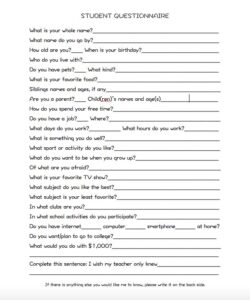Ever find yourself needing to gather thoughts from your students, or maybe even your peers, but not quite sure where to begin? Whether you’re a professor looking for feedback on a new teaching method, a student leading a group project, or someone trying to gauge interest in a campus event, getting good, organized input can feel like a mountain to climb. The good news is, it doesn’t have to be a complicated ordeal that eats into your already packed schedule.
Creating an effective survey from scratch often means wrestling with question phrasing, formatting, and making sure you cover all your bases. This is where having a reliable framework can make all the difference. Imagine having a ready-made structure that guides you through the process, ensuring you collect meaningful data without the headache. It’s about streamlining your efforts so you can focus on what truly matters: understanding the insights you receive.
Crafting the Perfect Survey for Your College Course
Designing a survey for a college setting, whether it’s for an entire class or a smaller group, requires thoughtful consideration to ensure you collect truly useful feedback. The primary goal is always to gather actionable insights, not just information for information’s sake. Before you even think about questions, it’s crucial to define your objectives. What specific information are you hoping to gain? Are you evaluating a recent lecture, assessing student comprehension of a topic, or gathering input for future course adjustments? Clearly defined goals will naturally lead to more focused and effective questions.
Different situations call for different types of surveys. For example, a mid-semester course evaluation might focus on teaching style, clarity of assignments, and overall learning environment. On the other hand, a survey for a group project might delve into team dynamics, individual contributions, and conflict resolution strategies. Each scenario demands a tailored approach, but they all benefit from a systematic structure. Considering the audience—your college students—is also vital; questions should be clear, unambiguous, and respectful of their time and perspective.
Key Elements of an Effective College Survey
Once your objectives are clear, you can begin to structure your survey. A good survey typically combines various question formats to capture a range of responses. Likert scales (e.g., “strongly agree to strongly disagree”) are excellent for gauging attitudes and opinions, while multiple-choice questions are great for specific facts or preferences. Open-ended questions are invaluable for qualitative feedback, allowing students to elaborate on their thoughts and provide nuanced insights that might not be captured by structured questions. Remember to consider anonymity; assuring students their responses are confidential can significantly increase participation and honesty.
- Clear and concise objectives stated upfront.
- A mix of question types to gather both quantitative and qualitative data.
- Anonymity or confidentiality assurances to encourage honest feedback.
- Logical flow and progression of questions, starting broad and narrowing down.
- A reasonable length to prevent survey fatigue among respondents.
- Opportunity for open-ended comments at the end for unprompted insights.
A structured approach, like utilizing a well-designed survey template for college class settings, truly simplifies this process. It provides a blueprint that ensures all essential components are included, from demographic questions (if needed for analysis) to specific feedback areas. By starting with a template, you’re not reinventing the wheel each time, but rather fine-tuning a proven framework to fit your specific needs, ultimately saving time and ensuring comprehensive data collection.
Leveraging a Survey Template for Maximum Impact
The beauty of starting with a pre-designed survey template is the incredible head start it gives you. Instead of staring at a blank page, trying to brainstorm every possible question, you have a foundational structure that already covers common and important areas. This not only saves a significant amount of time but also helps ensure consistency if you plan to administer similar surveys multiple times, perhaps at different points in the semester or across various courses. It means less time spent on formatting and more time focused on the content that matters most to your specific objectives.
While a template provides a solid starting point, its true power lies in its adaptability. A general survey template for college class feedback might include sections on lecture clarity, assignment fairness, and instructor accessibility. However, you can (and should) customize it to your unique course content or research questions. If you just covered a complex theory, you might add specific questions to gauge understanding of that particular concept. If your class involves a lot of group work, expanding the section on team dynamics would be beneficial. Personalizing the template makes the survey directly relevant and ensures you capture the most valuable data.
Once your survey is perfected, the next step is effective distribution and encouraging participation. Online survey tools are often the most efficient for college students, as they can access them anytime, anywhere. Clearly communicate the purpose of the survey and how the feedback will be used. Emphasize that student input genuinely helps improve the learning experience. Sometimes, setting aside a few minutes at the beginning or end of a class for students to complete the survey can significantly boost response rates. Reassuring them about anonymity is also key to fostering honest and candid feedback.
Finally, collecting the data is only half the battle; analyzing it is where the real insights emerge. Look for patterns, common themes in open-ended responses, and areas where there’s a strong consensus or significant divergence of opinion. Don’t just look at the numbers; try to understand the ‘why’ behind them. Once you’ve analyzed the results, consider sharing a summary of the findings and any changes you plan to implement based on the feedback with your students. This “closing the loop” demonstrates that their opinions are valued and reinforces the importance of their participation in future surveys.
Gathering feedback from college students is an indispensable part of fostering a dynamic and responsive educational environment. Whether you’re a faculty member striving for pedagogical excellence or a student aiming to improve group collaboration, the insights gained from well-executed surveys can illuminate pathways for growth and refinement. It’s a powerful tool for understanding perspectives, identifying strengths, and pinpointing areas that could benefit from adjustment.
By approaching feedback collection with a structured yet adaptable method, you empower yourself to make informed decisions that genuinely enhance the academic experience for everyone involved. Investing a little time in a thoughtful survey design ultimately leads to a more engaging, effective, and supportive learning community within the college setting.



